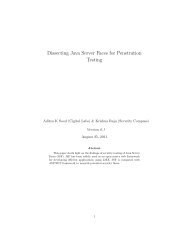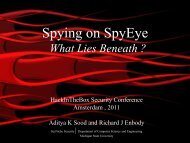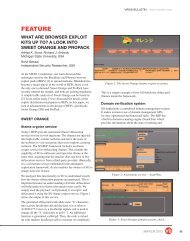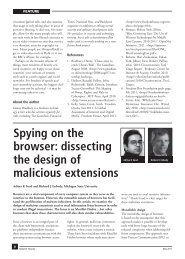browser exploit packs â exploitation tactics - SecNiche Security Labs
browser exploit packs â exploitation tactics - SecNiche Security Labs
browser exploit packs â exploitation tactics - SecNiche Security Labs
Create successful ePaper yourself
Turn your PDF publications into a flip-book with our unique Google optimized e-Paper software.
BROWSER EXPLOIT PACKS – EXPLOITATION TACTICS SOOD & ENBODY<br />
function geoip_country_name_by_addr($gi, $addr) {<br />
if ($gi->databaseType == GEOIP_CITY_EDITION_REV1) {<br />
$record = geoip_record_by_addr($gi,$addr);<br />
return $record->country_name;<br />
} else {<br />
$country_id = geoip_country_id_by_addr($gi,$addr);<br />
if ($country_id !== false) {<br />
return $gi->GEOIP_COUNTRY_NAMES[$country_id];<br />
}<br />
}<br />
return false;<br />
}<br />
function getdnsattributes ($l,$ip){<br />
$r = new Net_DNS_Resolver();<br />
$r->nameservers = array(“ws1.maxmind.com”);<br />
$p = $r->search($l.”.” . $ip .”.s.maxmind.com”,”TXT”,”IN”);<br />
$str = is_object($p->answer[0])?$p->answer[0]->string():’’;<br />
ereg(“\”(.*)\””,$str,$regs);<br />
$str = $regs[1];<br />
return $str;<br />
}<br />
Listing 5: BlackHole BEP – MaxMind GeoIP stat functions.<br />
$user_agent = $_SERVER[‘HTTP_USER_AGENT’]<br />
function get<strong>browser</strong>ver(& $MSIEversion, & $OPERAversion) {<br />
$uag = $_SERVER[‘HTTP_USER_AGENT’];<br />
if ( strstr( $uag, “Firefox” ) ) {<br />
if ( preg_match( “#Firefox/(\\d+\\.?\\d*\\.?\\d*)#s”, $uag, $mt ) ) {<br />
return “Firefox v{$mt[1]}”; }<br />
return “Firefox”; }<br />
........................<br />
function get<strong>browser</strong>type( ) {<br />
$uag = $_SERVER[‘HTTP_USER_AGENT’];<br />
if ( strstr( $uag, “Opera” ) ) { return “Opera”; }<br />
if ( strstr( $uag, “Firefox” ) ) {return “Firefox”; }<br />
if ( strstr( $uag, “MSIE” ) ) { return “MSIE”; }<br />
return “Other”;<br />
}<br />
Listing 6: UAF and <strong>exploit</strong> serving by the BlackHole BEP.<br />
The BlackHole BEP uses an advanced Traffic Distribution<br />
System (TDS) to handle data from various parts of the world.<br />
Once the location of the victim is determined, information<br />
about various metrics such as IP address, location, country,<br />
successful hits and malware downloads is collected. The TDS<br />
plays a crucial role in managing data from various sources.<br />
BlackHole uses a traffic redirection script that is visited by<br />
every infected system through HTTP. Different types of rules<br />
are configured for segregating data based on the geographical<br />
locations (IP addresses). As discussed earlier, widgets are used<br />
explicitly in BlackHole. Generally, widgets are designed to<br />
manage incoming data by separating them into desired metrics<br />
(IP addresses, country, hits, etc.) that are configured in the<br />
admin panel. Primary and secondary rules are defined to handle<br />
traffic data by redirecting the visitors to appropriate widgets.<br />
After understanding the details of the BlackHole BEP, we<br />
categorized the information gathering and <strong>exploit</strong> techniques.<br />
This process is followed in order to generalize the infection<br />
strategies. In the next section, we will<br />
discuss some of the chosen <strong>exploit</strong> serving<br />
techniques used by BEPs.<br />
BEP TECHNIQUES<br />
Exploit <strong>packs</strong> have the potential to steal<br />
information from users’ <strong>browser</strong>s by<br />
hooking different component interfaces<br />
and <strong>exploit</strong>ing vulnerabilities in the<br />
various components. The following<br />
techniques have been incorporated in the<br />
<strong>browser</strong> <strong>exploit</strong> <strong>packs</strong> for spreading<br />
malware infection and bypassing anti-virus<br />
protections.<br />
User Agent Fingerprinting (UAF)<br />
User agents are defined as the client<br />
applications that are used to send HTTP<br />
requests to the server. In general, user<br />
agents implement the network protocol<br />
that is required for client-server<br />
communication. From a wider perspective,<br />
the user agent parameter (request header)<br />
in the HTTP request carries information<br />
about the <strong>browser</strong> environment. The user<br />
agent parameter provides information<br />
regarding the type of <strong>browser</strong>, the<br />
operating system and the security model.<br />
As stated in RFC 2616 [16], user agent<br />
strings are meant for statistical purposes.<br />
Concurrent with the rise of infections<br />
based on BEPs, user agent fingerprinting is<br />
also proliferating. BEP writers are<br />
<strong>exploit</strong>ing the functionality of the user<br />
agent because it transmits information<br />
from the victim machine to the destination.<br />
For example: the user agent transmits<br />
information as {User-Agent: Mozilla/4.0<br />
(compatible; MSIE 8.0; Windows NT 5.1;<br />
Trident/4.0;Mozilla/4.0 (compatible; MSIE<br />
6.0; Windows NT 5.1; SV1) )}. BEP<br />
writers can capitalize on this information<br />
and transform the attack. A prototype of<br />
UAF that is used to serve <strong>exploit</strong>s is<br />
presented in Listing 6.<br />
In general, the IE 6.0 <strong>browser</strong> is still widely <strong>exploit</strong>ed. User<br />
agent strings having traces of IE 6.0 are more likely to get<br />
served with the malware. Malware analysts can take<br />
advantage of that feature to ensure they have an infection to<br />
analyse. It is also important to set up that attractive<br />
environment on initial contact because BEPs reduce the<br />
possibility of detection by mapping the user agent for a<br />
particular IP address and not serving up an <strong>exploit</strong> after the<br />
first contact. Figure 4 shows the information disclosed from<br />
one of the test systems during the analysis.<br />
IP logging detection trick (IPLDT)<br />
BEPs continually get smarter. Earlier <strong>exploit</strong> <strong>packs</strong> served<br />
malware without keeping records of the IP address. This type<br />
of infection comes under the standard relation 1: N or N: 1<br />
considering the malware spreading pattern. BEPs were<br />
VIRUS BULLETIN CONFERENCE OCTOBER 2011<br />
5












